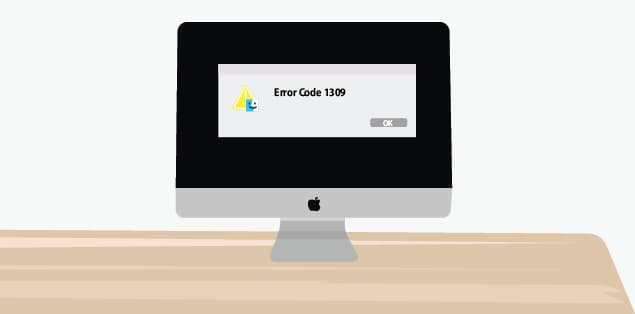What Is Error Code 1309 on Mac. This is the question right now in your head. Error Code 1309 on Mac is a prevalent error on macOS X.
There are so many computer errors, but Mac users often get the lucky bunch of error code 1309. While most Mac users laughed at this error code because of its absurdity, don’t get your hopes up yet. Error Code 1309 on Mac is a generic error code that means the application or process has been terminated.
Though it can seem pretty worrisome, the mac error is usually easy to fix. Error code 1309 on Mac can be severe, and if you don’t get rid of it quickly, it could also lead to damage or malfunctioning of your Mac machine.
What Is Mac Error Code 1309?

Mac is an operating system popularly known for its user-friendliness and reliability; however, Mac users may sometimes face specific errors while using their systems. One such error is the Mac Error Code 1309.
Mac error code 1309 is one of the most annoying errors you’ll encounter while using your Mac. This particular issue occurs when you are trying to copy or move a file and is typically displayed in the following file format: “The Finder can’t complete the operation because some data in “FileName” can’t be read or written.
(Error code -1309)” Unfortunately, there isn’t just one cause for this error—a variety of different issues usually causes it.
- An incomplete installation of the software.
- Corrupted files.
- Overloaded preferences files
- Abrupt interruption in system shut down.
- Virus or malware infection on the computer.
- Deleted or lost file or folder.
How Do I Fix Error Message 1309?
If you’re getting error code 1309 on your Mac, you probably already know you’re in for a frustrating experience. It means that your computer has an error reading or writing to a file or folder. You can usually fix the problem by restarting your computer, but there might be a deeper issue if that doesn’t work (or if it’s just happening too frequently). There are other methods enlisted you an use it to get rid of mac error 1309-
- To solve error 1309, press the Go button followed by Go to Folder. Type “/Library/” in the box and press enter. In the Library’s Preferences folder, click on the program causing the error and click the Delete button. Restart the problematic program.
Update macOS and Outdated Apps
To get the latest version of macOS, go to the Apple menu (top-left) > select System Preferences > Software Update. If a new version of macOS is available, you’ll see it in that window. Click Update/Upgrade Now and follow the on-screen steps to install it.
Clean the Login Items
Open System Preferences and select Users & Groups from the Apple menu. Select the user accounts you are logged into and click on Login Items in the toolbar. Remove all login items by clicking the minus (-) button to the left of each entry. Then, restart your Mac and see if the error is resolved. If this fixed the problem, you could start re-adding login items one by one—restarting your Mac after each—to pinpoint which item was causing the problem and keep only that one removed from the list.
Repair Mac Disk permissions with Mac Disk Utility
To access the Repair Disk Partitions window:
- Open a Spotlight search by pressing Command + Space.
- Enter in Disk Utility and press enter.
- Select your system partition.
- Choose Repair Disk Partitions and wait while the process automatically fixes any issues.
How Do I Transfer Large Files From My Mac to My External Hard Drive?
We get it. When you have a Mac computer, you’re used to everything just working. So you never have to stress about transferring files from one place to the next, right?
But sometimes, there’s just no other option but to transfer large files—like all of your photos, videos, and documents—from your Mac to an external hard drive.
It can be tricky if you haven’t done it before, but we’re here to walk you through it! Here are our three favorite methods for transferring large files from your Mac to an external hard drive:
If you’re looking to transfer a large file from your Mac to an external hard drive, you’ve come to the right place! If your computer is running out of storage space, we’ll help you find a solution.
Step 1: Connect the External Hard Drive
The first step is to connect your external hard drive to your Mac. You can do this using a USB cable. Once you’ve connected it, make sure that it’s turned on and ready to use.
Step 2: Find Your File
Next, we need to find the file you want to move and open it up in Finder. To do this, click on the “Finder” application located at the bottom of your screen and then click on “File” in the menu bar at the top. This will open up Finder in a new window where you can browse through your files and folders. The file’s location that needs moving will vary depending on whether or not you saved it directly onto your desktop or somewhere else within one of these folders (like Documents).
Once you’ve found your file, right-click on it with your mouse or trackpad (or hold down Ctrl while clicking if you’re using an Apple keyboard) and select “Show Package Contents” from the dropdown.
Another way is to use an app or utility-specific to transfer data between devices. For example, if you have a Mac and want to transfer a large file from your Mac onto your iPhone, you can do it using an app like AirDrop. You can also use AirDrop if you have an iPad and want to transfer a large file from your iPad onto your Mac.
Another option is to use a cloud storage service such as Google Drive, Dropbox, or iCloud Drive. These services allow you to store files in the cloud and then access them on any device with an internet connection.
What Is Error Code 36 in Mac While Copying?
Error code 36 is an unexpected error when your computer tries to copy items from one place to another and can’t. It’s a frustrating error caused by how your computer’s file system manages data. Don’t worry, though—we’re here to help you fix it.
We’ve put together this guide to help you understand what causes Error Code 36 and how you can fix it. For example, if you’re looking for a simple fix, we recommend automatically using Outbyte macAries to solve the problem.
What Causes Error Code 36?
The cause of Error Code 36 is relatively simple: Your computer needs more information than just the name of the file it wants to copy. So even though the Finder interface doesn’t show those kinds of details, it stores information about every file on your hard drive—information like when you created it, where you stored it, its size, and permissions.
When your computer copies files on your hard drive, it uses information like this to decide what to do with new files and how to manage them. For example, if two files have identical names but different sizes or dates of creation, your computer system will store them as separate items, even though they share a name. When this happens, your Mac starts showing error 36.
If you are trying to copy data from one drive and the transfer stops for some reason, you may see the error code 36 on your Mac computer.
Here is how you can fix the error:
- Open Finder on your Mac computer
- Open “Go” from the top menu bar and select “Go to Folder”
- In the box that opens, type “/etc.”
- Double-click on “com.apple.finder.plist” and open it with TextEdit
- Locate “NSTableColumns of Browser Columns” and delete that line of text if it exists
- Save the file and restart your computer
Final words – What Is Error Code 1309 on Mac?
If you’re wondering what causes 1309 on Mac, the most likely culprit is your Mac’s preference files. You may overload the preferences files when you have so many things going on, including multiple app installations, enabled add-ons, and plug-ins (like for browsers). You must also examine network settings to solve this problem.
This Error Code 1309 is relatively easy to fix and doesn’t require advanced Apple knowledge. Apply one of the suggestions mentioned above, and get rid of error 1309.
Enjoy your Mac journey.
